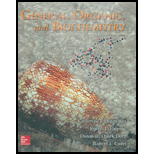
Concept explainers
(a)
Interpretation:
One physical and one chemical property of the block of wood has to be given.
Concept Introduction:
Physical properties:
The properties which are measured or observed without change in composition of matter are said to be physical properties. These includes appearance, texture, color, odor, melting point, boiling point, density, solubility, polarity and so on.
Chemical properties:
The properties that are observed when a substance undergoes any
(a)
Explanation of Solution
The physical property of a block of wood is shape of the block.
The chemical property of wood is tendency to burn. When wood is burnt, it becomes ash and the chemical change occurs in the reaction.
(b)
Interpretation:
The properties mentioned in part (a) has to be labelled as intensive or extensive property.
Concept Introduction:
Intensive property:
The property which does not depends on the amount of matter is said to be an intensive property. The change in the volume or mass of the matter does not affect intensive properties.
Extensive property:
The property which depends on the amount of the matter is said to be an extensive property. The change in the volume or mass of the matter changes the extensive properties.
(b)
Explanation of Solution
The shape of the wood block is intensive property. It does not depend on mass or volume of the block.
The burning of wood block is extensive property. The mass and volume of the wood changes after the chemical reaction.
(c)
Interpretation:
A block of wood measures
(c)
Explanation of Solution
Given, height of the wood block
The volume of the block of the wood can be calculated by multiplication of height, width and depth.
(d)
Interpretation:
A block of wood measures
Concept Introduction:
The conversion of inches to centimeters can be done by the conversion factor.
(d)
Explanation of Solution
Given, height of the wood block
By using the conversion factor, the units are converted.
Height of the block:
Width of the block:
Depth of the block:
(e)
Interpretation:
A block of wood measures
(e)
Explanation of Solution
Given, height of the wood block
The measurements of block in centimeters is given as height of the block is
The volume of the block of the wood can be calculated by multiplication of height, width and depth.
(f)
Interpretation:
By using the value obtained for the volume of the block of wood, the mass of the block of wood has to be calculated. The density of wood is
(f)
Explanation of Solution
Density is the ratio of mass and volume of a sample.
Given, density as
The mass of the block of wood is
Want to see more full solutions like this?
Chapter 1 Solutions
GENERAL,ORGANIC,+BIOCHEM.(LL) >CUSTOM<
- Synthesize 2-Ethyl-3-methyloxirane from dimethyl(propyl)sulfonium iodide using the necessary organic or inorganic reagents. Draw the structures of the compounds.arrow_forwardSynthesize 2-Hydroxy-2-phenylacetonitrile from phenylmethanol using the necessary organic or inorganic reagents. Draw the structures of the compounds.arrow_forwardSynthesize N-Methylcyclohexylamine from cyclohexanol using the necessary organic or inorganic reagents. Draw the structures of the compounds.arrow_forward
- Synthesize N-Methylcyclohexylamine from cyclohexanol using the necessary organic or inorganic reagents. Draw the structures of the compounds.arrow_forwardIf possible, please provide the formula of the compound 3,3-dimethylbut-2-enal.arrow_forwardSynthesize 1,4-dibromobenzene from acetanilide (N-phenylacetamide) using the necessary organic or inorganic reagents. Draw the structures of the compounds.arrow_forward
- Indicate the products obtained by mixing (3-oxo-3-phenylpropyl)triphenylphosphonium bromide with sodium hydride.arrow_forwardWe mix N-ethyl-2-hexanamine with excess methyl iodide and followed by heating with aqueous Ag2O. Indicate the major products obtained.arrow_forwardIndicate the products obtained by mixing acetophenone with iodine and NaOH.arrow_forward
- Indicate the products obtained by mixing 2-Propanone and ethyllithium and performing a subsequent acid hydrolysis.arrow_forwardIndicate the products obtained if (E)-2-butenal and 3-oxo-butanenitrile are mixed with sodium ethoxide in ethanol.arrow_forwardQuestion 3 (4 points), Draw a full arrow-pushing mechanism for the following reaction Please draw all structures clearly. Note that this intramolecular cyclization is analogous to the mechanism for halohydrin formation. COH Br + HBr Brarrow_forward
 ChemistryChemistryISBN:9781305957404Author:Steven S. Zumdahl, Susan A. Zumdahl, Donald J. DeCostePublisher:Cengage Learning
ChemistryChemistryISBN:9781305957404Author:Steven S. Zumdahl, Susan A. Zumdahl, Donald J. DeCostePublisher:Cengage Learning ChemistryChemistryISBN:9781259911156Author:Raymond Chang Dr., Jason Overby ProfessorPublisher:McGraw-Hill Education
ChemistryChemistryISBN:9781259911156Author:Raymond Chang Dr., Jason Overby ProfessorPublisher:McGraw-Hill Education Principles of Instrumental AnalysisChemistryISBN:9781305577213Author:Douglas A. Skoog, F. James Holler, Stanley R. CrouchPublisher:Cengage Learning
Principles of Instrumental AnalysisChemistryISBN:9781305577213Author:Douglas A. Skoog, F. James Holler, Stanley R. CrouchPublisher:Cengage Learning Organic ChemistryChemistryISBN:9780078021558Author:Janice Gorzynski Smith Dr.Publisher:McGraw-Hill Education
Organic ChemistryChemistryISBN:9780078021558Author:Janice Gorzynski Smith Dr.Publisher:McGraw-Hill Education Chemistry: Principles and ReactionsChemistryISBN:9781305079373Author:William L. Masterton, Cecile N. HurleyPublisher:Cengage Learning
Chemistry: Principles and ReactionsChemistryISBN:9781305079373Author:William L. Masterton, Cecile N. HurleyPublisher:Cengage Learning Elementary Principles of Chemical Processes, Bind...ChemistryISBN:9781118431221Author:Richard M. Felder, Ronald W. Rousseau, Lisa G. BullardPublisher:WILEY
Elementary Principles of Chemical Processes, Bind...ChemistryISBN:9781118431221Author:Richard M. Felder, Ronald W. Rousseau, Lisa G. BullardPublisher:WILEY





